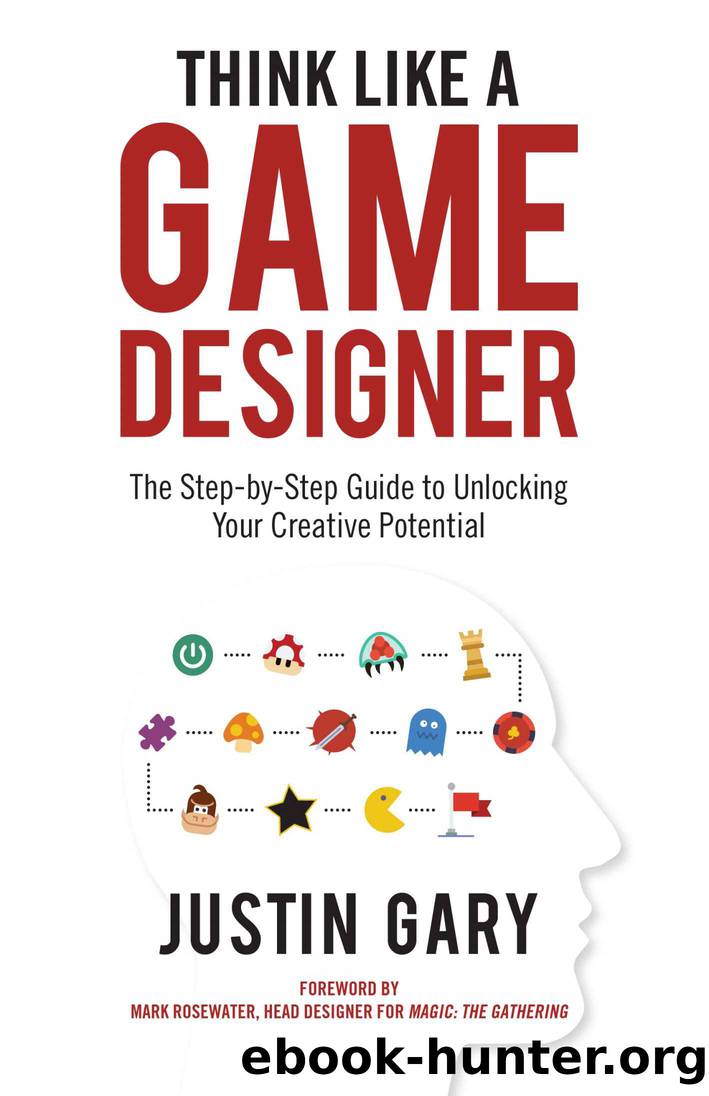Think Like A Game Designer: The Step-by-Step Guide to Unlocking Your Creative Potential by Justin Gary

Author:Justin Gary [Gary, Justin]
Language: eng
Format: epub
Publisher: Aviva Publishing
Published: 2018-09-09T05:00:00+00:00
By answering these questions, you will begin to get a feel for what belongs in a category and what doesnât. You will inevitably flesh out more details over time, but the big picture questions above are enough to get started.
In Magic: The Gathering, cards are broken down into colors. Each color has a theme (e.g., red is about fire, passion, and living in the moment). Each color has mechanical strengths (e.g., red is the best at doing damage quickly) and mechanical weaknesses (e.g., red cannot destroy enchantments and has few flying creatures). By knowing the categoryâs details, it is both easier for a designer to make cards that belong in a color as well as for players to understand why they might want (or not want) to have red cards in their deck.
In games like World of Warcraft, you must select a class to begin the game. Each class has a strictly defined set of abilities and advancement trees. Warriors, for example, can take a lot of damage and work best at close range. Each class determines which items you will be able to use and the role you will play in raids. Roles include Tanks (designed to absorb damage and protect other players), Healers, and DPS (designed to maximize âdamage per secondâ to take out enemies quickly). These roles, while not formally presented in the game, represent even higher level categories that each class falls into, and they further help to divide and understand new classes as they are introduced.
SUBCATEGORIES
Subcategories (aka subtypes, subthemes) give you more ways to divide your components. Think of your categories as the Russian nesting dolls of structure. Each layer can contain within it increasingly refined levels of detail. Once you have defined the top level, repeat the same process to create subthemes within each category.
In World of Warcraft, Warlocks are a class of magic users who power their magic with health and sacrifice. But each talent tree has its own particular focus. Demonology Talent Warlocks generally focus on summoning strong creatures to fight for them, while Affliction Warlocks focus on putting negative effects on their enemies to hurt them over time. In Magicâs green color, which is about growth and nature, Elves tend to provide additional resources while Beasts tend to be larger creatures intended for attacking.
CYCLES
A cycle is a single theme or pattern that repeats itself across multiple categories. You can also have cycles within a category to highlight a key feature (e.g., have a small, medium, and large version of a core effect). Cycles are one of the best ways to establish your themes and communicate them to players.
In basic games like Monopoly, cycles are easy to spot. When I compare the two-color set of Boardwalk and Park Place to the two-color set of Baltic and Mediterranean Avenues, I can easily understand that Boardwalk is much more expensive and valuable. Often, even in complex collectible games, the cycles jump out at you right away. One of the most famous trading card game cycles is from Magicâs very first set.
Download
This site does not store any files on its server. We only index and link to content provided by other sites. Please contact the content providers to delete copyright contents if any and email us, we'll remove relevant links or contents immediately.
| Business School Guides | GMAT |
| Guides | Interviewing |
| Job Hunting | Job Markets & Advice |
| Resumes | Vocational Guidance |
| Volunteer Work |
The Motivation Myth by Jeff Haden(5142)
Audition by Ryu Murakami(4822)
Adulting by Kelly Williams Brown(4464)
The Confidence Code by Katty Kay(4173)
A Mind For Numbers: How to Excel at Math and Science (Even If You Flunked Algebra) by Barbara Oakley(3206)
Waiting in the Wings by Melissa Brayden(3170)
Self-Esteem by Matthew McKay & Patrick Fanning(3079)
Fooled by Randomness: The Hidden Role of Chance in Life and in the Markets by Nassim Nicholas Taleb(3025)
The ONE Thing by Gary Keller(2993)
Nice Girls Don't Get the Corner Office by Lois P. Frankel(2985)
The Dictionary of Body Language by Joe Navarro(2936)
How to be More Interesting by Edward De Bono(2732)
Designing Your Life by Bill Burnett(2656)
Getting Things Done by David Allen(2630)
The Plant Paradox by Dr. Steven R. Gundry M.D(2528)
Police Exams Prep 2018-2019 by Kaplan Test Prep(2467)
What Color Is Your Parachute? 2015 by Richard N. Bolles(2249)
Dangerous Personalities by Joe Navarro(2222)
When to Jump by Mike Lewis(2147)
